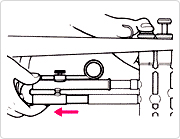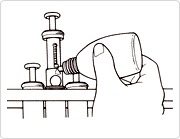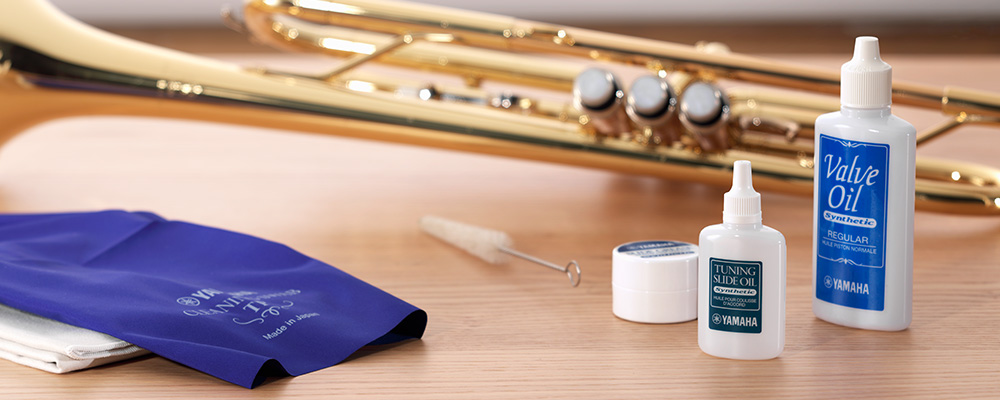Care and Maintenance of a Trumpet
Care and maintenance after playing
First remove moisture from the slides
Remove each slide carefully while holding down the corresponding piston, as shown in the diagram. A popping sound indicates that you are not removing the slide properly. Extract the moisture from the slide which you have removed. Remove the moisture from the body of the trumpet as well, via the water key.

*Although brass and nickel-silver-the materials which are used for slides-are extremely resistant to corrosion, there is a danger of progressive corrosion if moisture remains in a slide for a long time.
*When removing a slide, be careful to hold down the corresponding piston.
Lubricating with valve oil
Undo the cap screw in the valve casing and slowly extract the piston upwards halfway, without allowing it to rotate. Now apply two or three drops of piston oil to the piston. Retighten the cap screw and move the piston up and down two or three times to work in the oil.

Valves can become sticky if not properly lubricated, so be sure to clean and oil them regularly.
Removing dirt from the surface of the instrument
Before replacing the instrument in its case, wipe its surface lightly with a polishing cloth to remove dirt.
Darkening of the silver finish
Trumpets finished with silver plating will darken even if polished meticulously every day. This is caused by a natural reaction between the silver metal and the sulphur content and oxygen in air and perspiration. However, the nature of this silver tarnish differs from that of iron and other metals, forming a thin film that contributes to protecting the surface of the instrument, so is not a cause for concern. On the contrary, there are some musicians who believe a discolored instrument produces a better sound because of the hardening effect.
If a clean finish is preferred for visual or aesthetic reasons, it would be best to shine the instrument with an abrasive such as silver polish. It is also possible to use a cloth that has been soaked in silver polish, known as a "silver cloth". When using silver polish, polish lightly by applying a small amount to a cloth and spreading thinly over the instrument.
Musical Instrument Guide:Trumpet Contents
Structure
How the Instrument is Made
Choosing an Instrument
Care and Maintenance
Trivia
- Trumpeters in Bach's time alternated between instruments with a variety of ranges when performing
- The keyed trumpet-the fruit of the evolutionary process
- Famous trumpet works - Concertos, part 1
- Famous trumpet works - Concertos, part 2
- Famous trumpet works - Solos
- Is a Flugelhorn a horn? Or a trumpet?
- The highest note a trumpet can produce
- Aida trumpets for the "Grand March"
- The secret of the trumpet's traditional tone: small impurities!?

